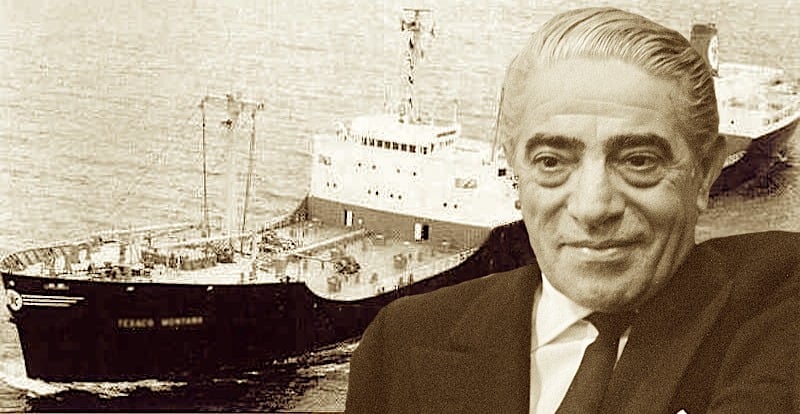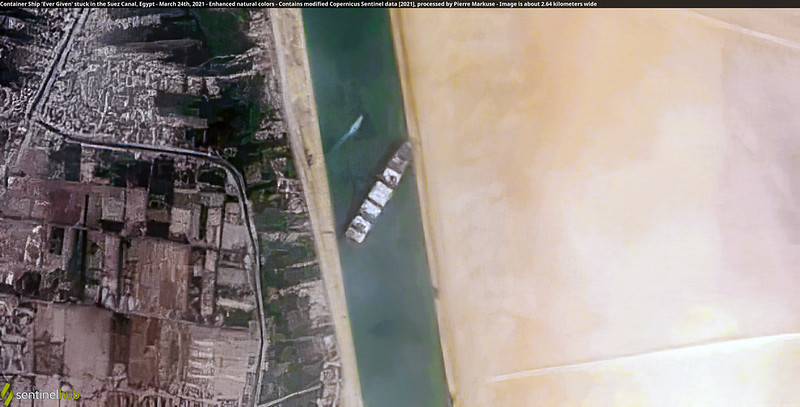
Egypt’s Suez Canal, which links the Mediterranean Sea with the Red Sea, thereby allowing direct shipping from Europe to Asia, remains blocked by the stuck container ship Ever Given for the fifth day.
Many have already tallied the catastrophic effects the blockage will have on the world economy.
Some suspect that the stuck ship will cost an estimated $6 to $10 billion in lost trade, as countless ships, loaded with precious cargo, have sat lined up to pass through the Suez Canal for days.
Rather than waiting, other vessels have chosen to make the trip around the entire continent of Africa, a route so long and arduous that the Suez Canal was built just to avoid it, in order to ship goods between Europe and Asia.

Onassis made his fortune when the Suez Canal was blocked in 1956
Although the current disruption of trade at the Suez Canal may be disastrous economically, its not the first time that the Suez was blocked, but the outcome then was the accumulation of a massive amount of wealth for one ship owner.
A similar event in the 1950s caused Aristotle Onassis, powerful Greek shipping magnate, to make his fortune.
In the early ’50s, Onassis worked out a deal with the King of Saudi Arabia to have exclusive rights to ship the country’s oil around the world.
After Onassis made the potentially lucrative deal, he purchased a series of tankers for the express purpose of shipping Saudi Arabia’s precious oil.
Due to the country’s massive amount of oil production, Onassis acquired a great number of ships.
This investment turned out to be potentially disastrous, however, when the Greek shipping magnate was blocked from transporting Saudi Arabia’s oil by the US.
US companies, which had a prior agreement with Saudi Arabia for exclusive shipping rights over the country’s oil, were outraged by Onassis’ deal, and the US government even stepped in.
Saudi Arabia deal turns into potential disaster
They refused to renew the charters of any of Onassis’ ships, and would not let his vessels load any oil when they reached port in Saudi Arabia, so the deal between the Greek shipowner and the country was abandoned.
The blockade of Onassis’ ship caused his incipient fortune to quickly drain, as his many vessels sat idle in the Red Sea.
Onassis even considered selling the massive fleet of tankers after he realized he could not afford to pay back the loans he had received initially to buy the ships.
His fortunes quickly turned, however, when Egypt cut off all access to the Suez Canal during the Suez Crisis in 1956, after Israel invaded the Sinai Peninsula and Gaza Strip.
The Suez Canal, one of the most important trade routes in the world, remained closed for 6 months.
Onassis’ massive, idle fleet meets global after Suez blocked
Then, like now, ships were forced to circumnavigate the entire continent of Africa, a considerably longer trip, and soon there were not enough tankers to fulfill global shipping demands due to the delays.
Luckily, Onassis had a massive fleet of ships that had sat unused, the perfect solution to a global need for extra tankers.
Onassis turned what could have been his ruin into a boon–as demand was so high, and his ships were not under contract, the Greek magnate had the power to set any price he desired to lease them out, and he made a fortune.
According to records, Onassis could make $2 million on a single trip with a full tanker at the time.
When the Suez Canal reopened six months later, Onassis had amassed a considerable fortune. In 1957 alone, he made $70 million, when just the year before he was drowning in debt.
Onassis made a name for himself as the most powerful and clever shipping magnate in the world, and he later became the wealthiest person on the planet.



Comments
Post a Comment